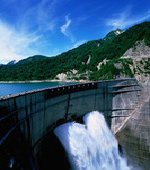 Improving the Water Quality of the Heavily Polluted Citarum River Could Yield Returns of at Least Two Times the Investments Made
Improving the Water Quality of the Heavily Polluted Citarum River Could Yield Returns of at Least Two Times the Investments Made
Cited as one of the world's 10 worst polluted places in the world, the Citarum River in Indonesia is a vital source of water supply for both the Bandung metropolitan area and the greater Jakarta region where almost 35 million people reside. By investing in improved domestic sanitation, municipal wastewater, industrial wastewater management, solid waste management and resource reuse over 20 years, by the year 2030 the annual benefits of US$280 million outweigh the annual equivalent costs of US$123 million.
A new Technical Paper jointly published by the Water and Sanitation Program (WSP) and the Asian Development Bank (ADB), Downstream Impacts of Water Pollution in the Upper Citarum River in West Java, Indonesia, presents an economic assessment of interventions to improve water quality in the upper Citarum River. The report highlights that with over two thirds of the water pollution from domestic and municipal activities, economic and financial benefits associated with improved sanitation and wastewater management in this River basin would be significant:
-2.3Rp of economic return for each rupiah spent
-US$226 million (Rp2.1 trillion) annually from improved water quality
-US$54 million (Rp500 billion) annually from the recycling of wastewater and solid waste
It also shows that improved water quality in the upper Citarum River does not only improve the quality of life of the people in the greater Bandung area, but also of all people living downstream who depend on this important water source.
The report – which follows up two previous Economics of Sanitation Initiative (ESI) studies launched in East Asia and the Pacific region in 2008 - describes the origins and effects of different pollution sources on water quality, the economic losses resulting from the deteriorating water quality, and feasible interventions.
A blog post isalso available, written by World Bank senior economist Guy Hutton on some of the key findings of the report.
For more information,
please visit www.wsp.org or
contact the authors at wspeap@worldbank.org
| Contact information |
World Bank Water
(email: worldbankwater@worldbank.org ; wspeap@worldbank.org ) |
|---|---|
| News type | Inbrief |
| File link |
https://blogs.worldbank.org/water/cleaning-one-world-s-most-polluted-places |
| Source of information | World Bank Water |
| Subject(s) | ANALYSIS AND TESTS , CHARACTERISTICAL PARAMETERS OF WATERS AND SLUDGES , DRINKING WATER , DRINKING WATER AND SANITATION : COMMON PROCESSES OF PURIFICATION AND TREATMENT , ENERGY , FINANCE-ECONOMY , HEALTH - HYGIENE - PATHOGENIC MICROORGANISM , HYDRAULICS - HYDROLOGY , INDUSTRY , INFORMATION - COMPUTER SCIENCES , INFRASTRUCTURES , MEASUREMENTS AND INSTRUMENTATION , METHTODOLOGY - STATISTICS - DECISION AID , NATURAL MEDIUM , PREVENTION AND NUISANCES POLLUTION , RISKS AND CLIMATOLOGY , SANITATION -STRICT PURIFICATION PROCESSES , SLUDGES , WATER QUALITY |
| Relation | https://www.wsp.org/content/east-asia-economic-impacts-sanitation |
| Geographical coverage | n/a |
| News date | 22/12/2013 |
| Working language(s) | ENGLISH |
 you are not logged in
you are not logged in





